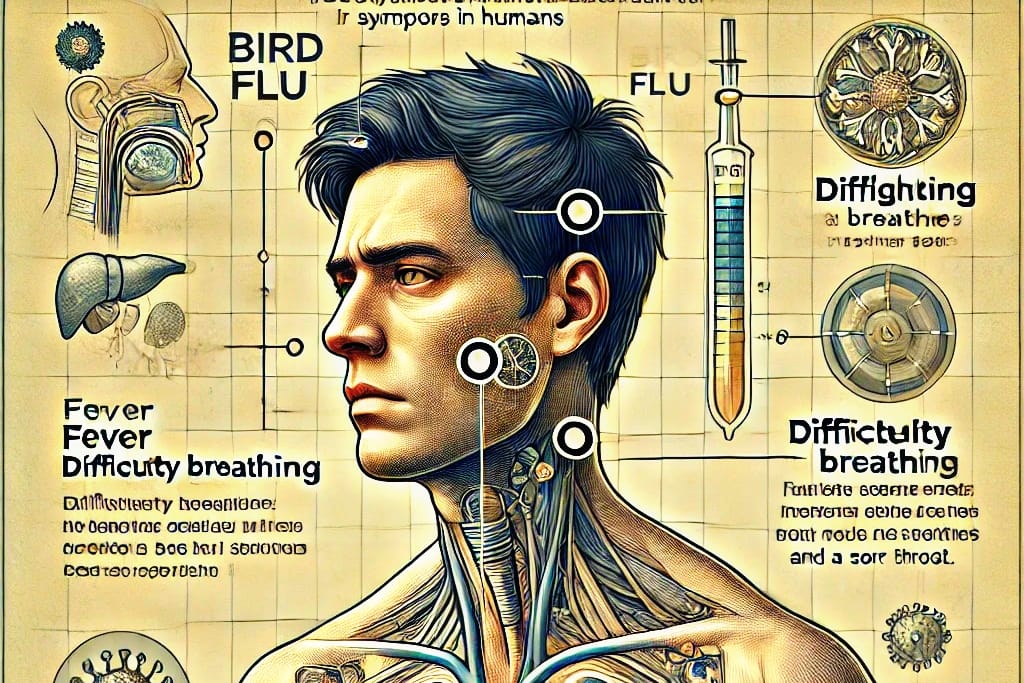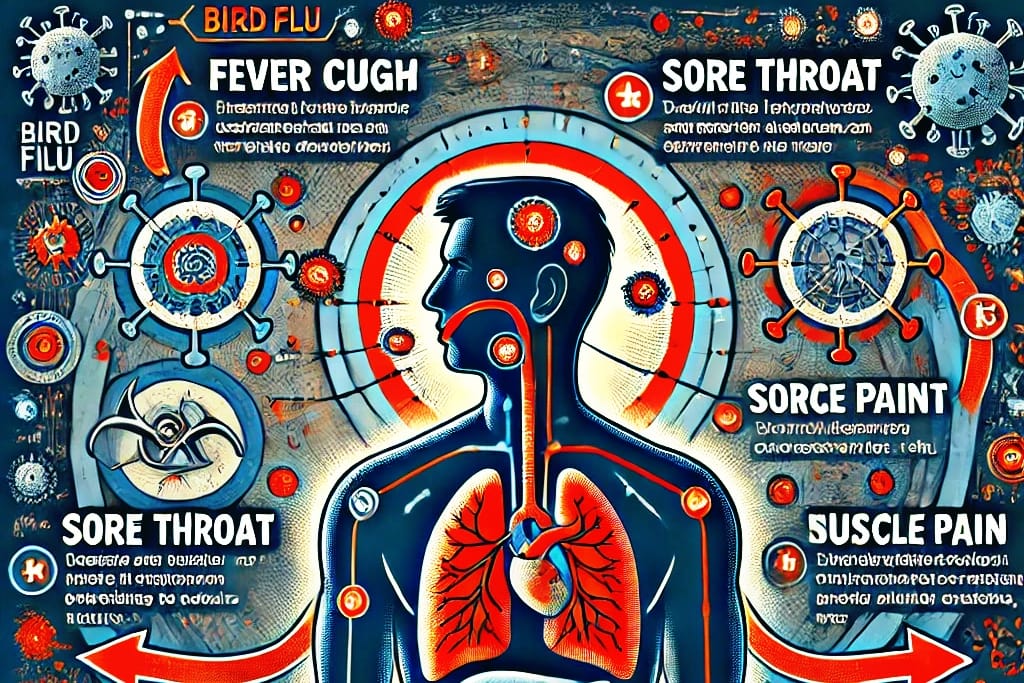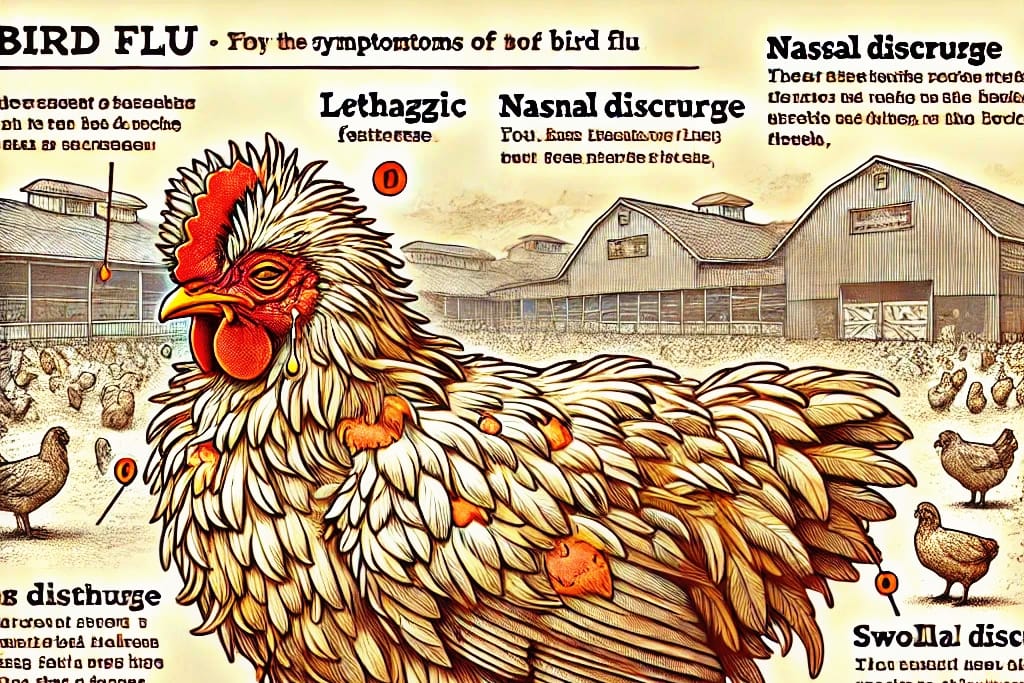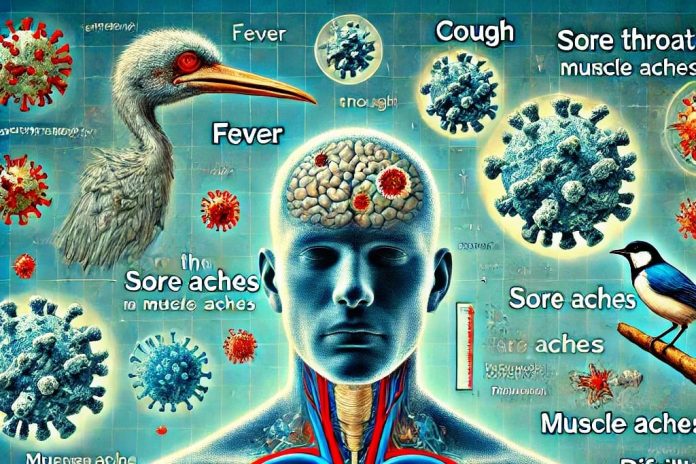Bird Flu Symptoms, also known as avian influenza Symptoms, is a viral infection primarily affecting birds, but it can sometimes be transmitted to humans, leading to serious health risks. Over the years, bird flu has made headlines due to outbreaks across various parts of the world, with concerns about its potential to cause a global pandemic. While the risk of human-to-human transmission remains low, understanding the Bird Flu Symptoms in humans, how it spreads, and the necessary preventive measures is essential for public health awareness.
In this comprehensive guide, we’ll explore bird flu symptoms, how the infection is transmitted, the types of bird flu viruses, the risk factors involved, and what you can do to protect yourself and others. Whether you’re a poultry farmer, a traveler, or simply curious, this article will provide a thorough understanding of this disease.
What is Bird Flu?

Bird flu is caused by the avian influenza virus, a group of viruses that primarily infect birds, especially waterfowl and domesticated poultry. While the infection mainly affects animals, certain strains of the virus can spread to humans, especially those who have close contact with infected birds or their droppings. Bird flu has been responsible for several significant outbreaks in recent decades, including the H5N1, H7N9, and H5N8 strains, which have led to significant public health responses.
The infection in birds typically causes mild symptoms or no symptoms at all, but some strains, like H5N1, can cause severe illness and death in birds. When the virus jumps from birds to humans, it can sometimes lead to serious health complications. However, human-to-human transmission of bird flu is relatively rare, and most cases of human infection are associated with direct or indirect exposure to infected birds.
Bird Flu Symptoms – How Does Bird Flu Spread?
The primary way bird flu spreads is through the droppings, saliva, and nasal secretions of infected birds. Wild birds, especially waterfowl, are natural reservoirs of avian influenza viruses and can spread the virus to domesticated poultry and other birds through their migratory routes.
Human infection typically occurs when a person comes into direct contact with infected birds or their contaminated environments. This might include handling live or dead poultry, cleaning poultry farms, or coming into contact with contaminated water or equipment. Bird flu symptoms in humans typically appear within a few days of exposure to the virus.
While human-to-human transmission of bird flu is rare, some strains, such as the H5N1 virus, have shown limited human-to-human spread, raising concerns about the potential for future pandemics.
Bird Flu Symptoms in Humans

The Bird Flu Symptoms in humans can vary depending on the strain of the virus, the person’s immune system, and whether they received medical treatment. Common symptoms of bird flu in humans often resemble those of the seasonal flu but can escalate more quickly in severe cases.
Early Bird Flu Symptoms
The early Bird Flu Symptoms in humans are similar to those of regular flu and may include:
- Fever: Often high-grade, above 101°F (38.3°C), and may not respond well to fever-reducing medications.
- Cough: A dry, persistent cough is common.
- Sore Throat: Like other respiratory infections, a sore throat may develop.
- Runny or Stuffy Nose: Nasal congestion or a runny nose is common.
- Fatigue and Weakness: A general feeling of weakness or fatigue may occur.
- Muscle Aches: Body aches and muscle pains can be part of the symptoms.
These Bird Flu Symptoms can worsen quickly, and other more severe signs may appear depending on the severity of the infection.
Severe Bird Flu Symptoms
In more severe cases of Bird Flu Symptoms can escalate rapidly. The most serious signs of bird flu in humans may include:
- Difficulty Breathing: Shortness of breath or rapid breathing due to severe pneumonia or lung complications.
- Chest Pain: Pain or tightness in the chest, a symptom of pneumonia or respiratory failure.
- Cyanosis: A bluish tint to the skin, lips, or nails, indicating poor oxygen levels in the blood.
- Confusion or Seizures: In severe cases, confusion or seizures may occur due to the effects of the virus on the brain.
- Organ Failure: Severe cases can lead to liver, kidney, or multi-organ failure, especially without prompt medical treatment.
Eye Infections (Conjunctivitis)
Some strains of the bird flu virus, like the H5N1, may cause eye infections. Symptoms of an eye infection include:
- Redness or swelling in the eyes
- Watery or discharge-filled eyes
- Pain or discomfort in the eyes
Types of Bird Flu Viruses and Their Risk to Humans

Not all strains of bird flu are equally dangerous to humans. Some strains are highly pathogenic and can cause severe illness, while others cause mild symptoms or are not capable of infecting humans at all.
H5N1
The H5N1 strain of avian influenza has been the most concerning in terms of human health. First identified in 1997, H5N1 has led to several human deaths, primarily in countries in Southeast Asia. This strain is highly pathogenic to birds and can cause a serious, sometimes fatal illness in humans. While human-to-human transmission is rare, the potential for the virus to mutate and become more transmissible remains a concern.
H7N9
The H7N9 strain of bird flu was first identified in humans in 2013 in China. It has caused several human infections, and while it is less deadly than H5N1, it still poses a significant threat. H7N9 has demonstrated the ability to spread to humans through poultry, and the infection can lead to severe pneumonia, respiratory failure, and death in some cases.
H5N8 and Other Strains
The H5N8 strain of bird flu, though typically not as dangerous to humans as H5N1 and H7N9, has caused outbreaks in poultry populations around the world. Although human infections are rare with this strain, authorities remain vigilant to monitor its potential spread.
Other avian influenza viruses such as H9N2 and H10N3 have caused sporadic human infections, but these have not yet led to widespread disease transmission in humans.
Risk Factors for Contracting Bird Flu

While Bird Flu Symptoms in humans remains rare, certain factors increase the risk of infection:
- Direct Contact with Infected Birds: Farmers, poultry workers, and individuals who handle live poultry are at the highest risk of contracting the virus.
- Handling Bird Products: People who work with or consume undercooked poultry or eggs from infected birds are also at risk.
- Proximity to Outbreak Areas: Those living near areas with known bird flu outbreaks are at higher risk, especially if they live in regions where wild waterfowl pass through.
- Weak Immune System: Individuals with compromised immune systems, such as the elderly, young children, and those with chronic health conditions, are more vulnerable to severe symptoms.
Prevention and Protection Against Bird Flu
Preventing bird flu involves minimizing the risk of exposure to the virus. Below are essential steps for protecting yourself from bird flu:
Personal Protection
- Avoid Contact with Sick or Dead Birds: If you come across dead or sick birds, do not touch them. Infected birds may carry the virus, and handling them increases the risk of transmission.
- Wear Protective Gear: Workers in the poultry industry should wear gloves, masks, and protective clothing when handling live birds or their droppings.
- Hand Hygiene: Wash your hands thoroughly with soap and water after handling birds, poultry products, or potentially contaminated surfaces.
Cooking and Handling Poultry
- Cook Poultry Thoroughly: Ensure that poultry and eggs are cooked at high temperatures to kill any potential virus. Chicken should be cooked to an internal temperature of at least 165°F (74°C).
- Avoid Raw Poultry: Avoid consuming raw or undercooked poultry or eggs.
Vaccination and Monitoring
- Vaccines for Poultry: Some regions vaccinate poultry against avian influenza to reduce the risk of outbreaks. However, there is currently no vaccine available for humans for most strains of the bird flu virus.
- Flu Vaccination: While the seasonal flu vaccine doesn’t protect against bird flu, it can help reduce the risk of flu-like illnesses that could be mistaken for bird flu.
Reporting and Surveillance
- Monitor Local Outbreaks: Stay informed about bird flu outbreaks in your area or places you plan to visit. Follow any guidelines or warnings issued by health authorities.
- Report Sick or Dead Birds: If you encounter sick or dead birds, report them to local health or wildlife authorities to help prevent further spread.
Conclusion
While the risk of contracting Bird Flu Symptoms is relatively low, the potential consequences of the disease highlight the importance of awareness and prevention. Early detection and treatment are crucial to preventing severe complications from bird flu, especially in high-risk populations. By taking the necessary precautions, understanding the Bird Flu Symptoms, and staying informed about outbreaks, individuals can reduce their exposure to this potentially deadly disease.

